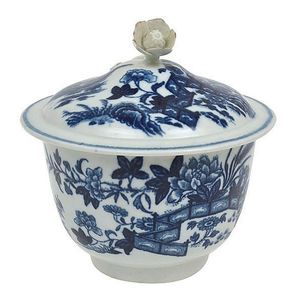Large Worcester Polychrome Lidded Sucrier with Floral Garlands
You must be a subscriber, and be logged in to view price and dealer details.
Subscribe Now to view actual auction price for this item
When you subscribe, you have the option of setting the currency in which to display prices to $Au, $US, $NZ or Stg.
- Floral Swag / Garland / Festoon - Floral swags are a decorative motif often used in the ornamentation of various objects, such as silverware, glassware, and furniture. The term "swag" refers to a garland or wreath of flowers, foliage, or other decorative elements, which is usually arranged in a loop or curve.
Floral swags can be found in a variety of decorative styles, from ornate Baroque and Rococo designs to more naturalistic Art Nouveau and Art Deco styles. They are often used to add a touch of elegance, refinement, or whimsy to an object, and can be seen on a range of items from chandeliers and candlesticks to picture frames and tea sets.
In the decoration of silver objects, floral swags are often used to accentuate the curves and lines of the piece, and to add visual interest to the surface. Similarly, on glass objects, floral swags may be used to frame or highlight a particular area of the object, or to add a touch of color and delicacy.
On furniture, floral swags can be found on a variety of pieces, from cabinets and armoires to chairs and sofas. They are often used to enhance the lines and curves of the furniture, and can be used to create a sense of movement and flow in the design.
Overall, floral swags are a versatile decorative element that can be adapted to a range of styles and applications, and have been used in the decoration of various objects throughout history. - Knop (ceramics) - In ceramics, a knop is a protuberance on the top of an object, and can be either decorative, or used as a knob to lift the item.
- Circa - A Latin term meaning 'about', often used in the antique trade to give an approximate date for the piece, usually considered to be five years on either side of the circa year. Thus, circa 1900 means the piece was made about 1900, probably between 1895 and 1905. The expression is sometimes abbreviated to c.1900.
- Polychrome - Made or finished in many colours. For furniture, it is used to indicated a painted finish.
This item has been included into following indexes:
Visually similar items

A blue and white covered jar decorated with two striding makara, first half of 16th century, 18 cm high with cover. Provenance: Rustam, Ujung Pandang, late 1960's

A Worcester porcelain covered sugar bowl late 18th century decorated with the Fence pattern, blue crescent mark to base, 12 cm high

A Royal Worcester potpourri, painted with wild flowers on a blush ground with gilt embellishments, restoration to lid, inner lid absent, with special back stamp to base. Height 19 cm

A famille-rose 'Balsam pear' teabowl and cover, seal mark and period of Daoguang, with steeply rounded sides flaring to the lipped rim, finely enamelled to the exterior with fruiting and flowering kugua vines entwined around a spray of leafy bamboo and wit
